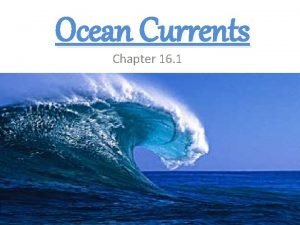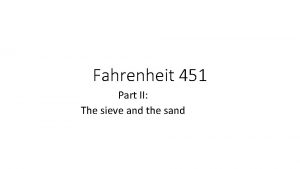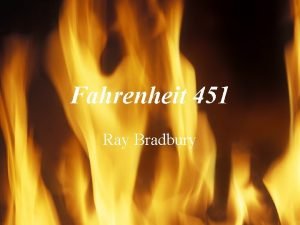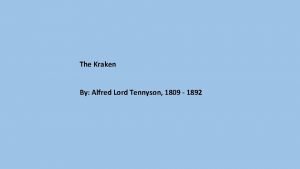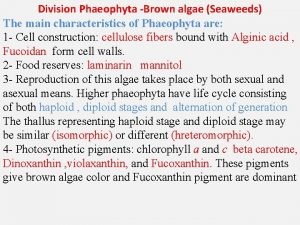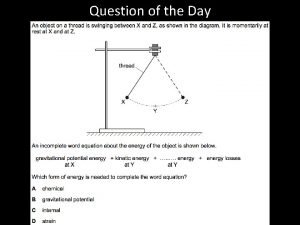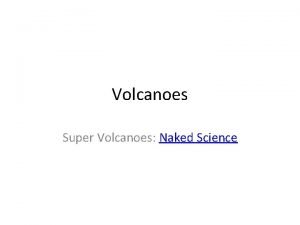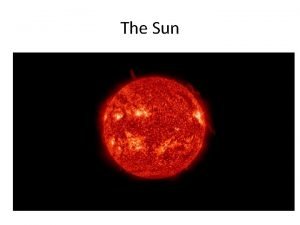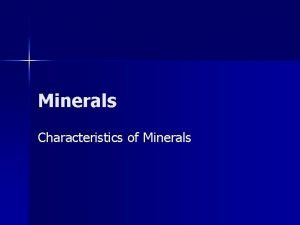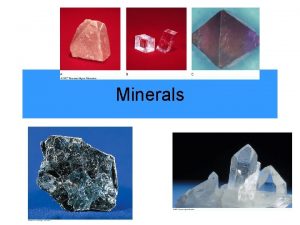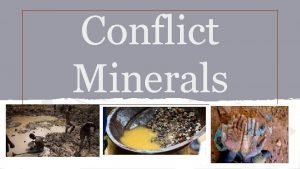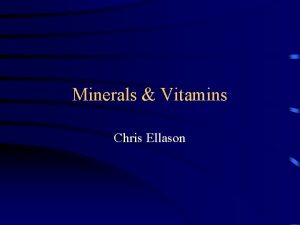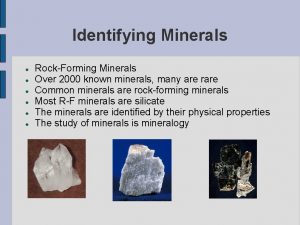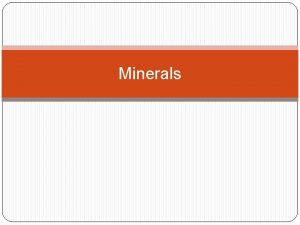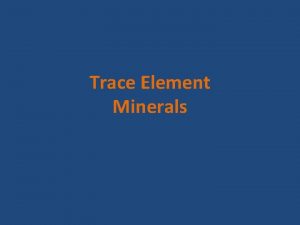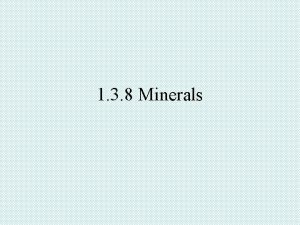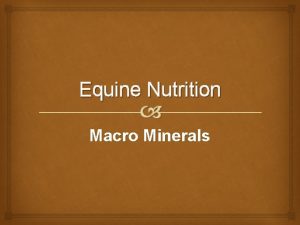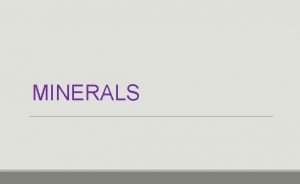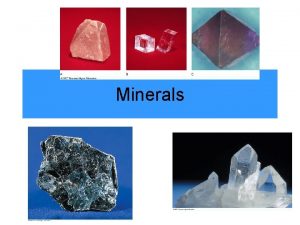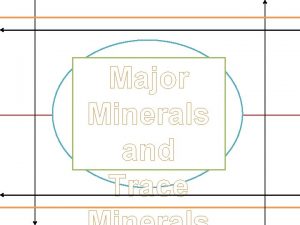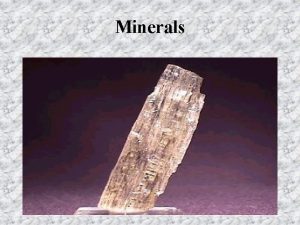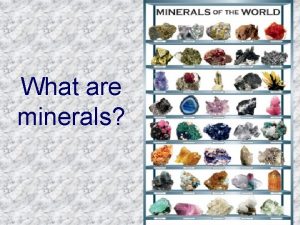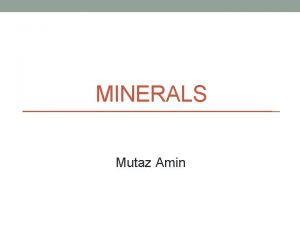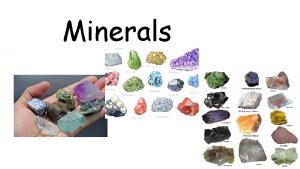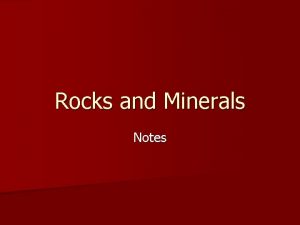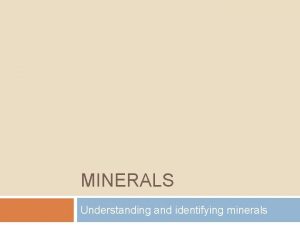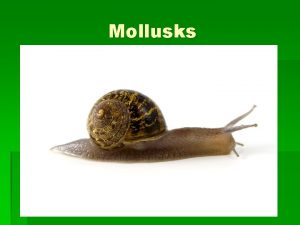Themes for Today A huge variety of minerals































































- Slides: 63

Themes for Today • A huge variety of minerals, but relatively few that make up most of the crust • Rocks are composed of minerals • The rock cycle describes the origin, transformation, and erosion of the three types of rocks: –igneous –sedimentary –metamorphic

Earth Materials – Minerals and Rocks http: //jan. ucc. nau. edu/~rcb 7/Vishnu 41. jpg

Earth Materials – Minerals • Minerals have many essential uses – common minerals like quartz: glass, sandpaper, optics – not-so-common like corundum (ruby): nail files, gemstones – everything in between • Basic units that make up most of Earth’s materials

Earth Materials – Rocks • Rocks are solid aggregates of minerals – (few exceptions) • Rocks also have many uses – crushed for aggregate in cement and for roadbeds – sawed and polished rocks for buildings, mantle pieces, and counter tops – soils are formed by alteration of rocks

Building a rock. . . Matter and Its Composition • Matter – is anything that has mass and occupies space – exists as solids, liquids, and gases – consist of elements and atoms • Element – is a chemical substance that cannot be chemically decomposed into simpler substances and is composed of tiny particles called atoms

Atoms • Atoms are the smallest units of matter that retain the characteristics of the element • Atoms have – a compact nucleus containing • protons – particles with a positive electrical charge • neutrons – electrically neutral particles – particles orbiting the nucleus • electrons – negatively charged particles

Structure of an Atom • Dense nucleus of an atom consisting of protons and neutrons • Surrounded by a cloud of orbiting electrons

Atoms • Atomic number = the number of protons – is constant • Atomic mass number = number of protons + number of neutrons – may vary due to varying numbers of neutrons

Isotopes • An element that has varying numbers of neutrons (and different atomic weights) has multiple isotopes • Different isotopes of the same element – have different atomic mass numbers – behave the same chemically • Isotopes are important in radiometric dating

Carbon Isotopes • Carbon atoms (with 6 protons) – have 6 neutrons = Carbon 12 (12 C) – have 7 neutrons = Carbon 13 (13 C) – have 8 neutrons = Carbon 14 (14 C) – thereby making up three isotopes of carbon.

Minerals—The Building Blocks of Rocks • A mineral’s composition is shown by a chemical formula – a shorthand way of indicating how many atoms of different kinds it contains – Quartz consists of Quartz: Si. O 2 1 silicon atom for every Ratio: 1: 2 2 oxygen atoms – Orthoclase consists of KAl. Si 3 O 8 1 potassium, 1 aluminum, and 3 silicon for every 1: 1: 3: 8 8 oxygen atoms

Native Elements • A few minerals consist of only one element • They are not compounds • They are known as native elements • Examples: – gold – formula: Au – diamond – formula: C

Minerals California Academy of Sciences in San Francisco

Minerals • Geological definition of a mineral: – naturally occurring – crystalline solid • crystalline means that minerals have an ordered internal arrangement of their atoms – a narrowly defined chemical composition – characteristic physical properties such as • density • hardness • color. . .

Crystalline Solids • By definition, minerals are crystalline solids – with atoms arranged in a specific 3 D framework • If given enough room to grow freely, – minerals form perfect crystals with – planar surfaces, called crystal faces – sharp corners – straight edges

Narrowly Defined Chemical Composition • Some minerals have very specific compositions – examples are halite (Na. Cl) or quartz (Si. O 2) • Others have a range of compositions – because one element can substitute for another if the atoms of the two elements have • the same electrical charge • and are about the same size – example: olivine • (Mg, Fe)2 Si. O 4 • iron and magnesium substitution in any proportion

Mineral Properties • Mineral properties are controlled by – Chemical composition – Crystalline structure • Mineral properties are used for mineral identification and include: • • color streak luster crystal form • • cleavage fracture hardness specific gravity

How Many Minerals Are There? • More than 3500 minerals are known • Only about 2 dozen are particularly common • Many others are important resources • Mineral groups: – minerals with the same negatively charged ion or ion group belong to the same mineral group • Most minerals in the crust – belong to the group called silicates

Silicates • Silicates are minerals containing silica – Si and O • They make up perhaps 95% of Earth’s crust – and account for about 1/3 of all known minerals

Types of Silicates • Ferromagnesian silicates – contain iron (Fe), magnesium (Mg), or both • Nonferromagnesian silicates – do not contain iron or magnesium

Ferromagnesian Silicates • Common ferromagnesian silicates include: – olivine – hornblende, an amphibole -group mineral – augite, a pyroxenegroup mineral – biotite mica

Nonferromagnesian Silicates Quartz Potassium feldspar Plagioclase feldspar Muscovite

Other Mineral Groups • Carbonates – minerals with carbonate ion (CO 3)-2 – as in calcite (Ca. CO 3), • found in limestone – and dolomite [Ca. Mg(CO 3)2], • found in dolostone • Other mineral groups are important, but more as resources than as constituents of rocks

Rock-Forming Minerals • Most rocks are solid aggregates of one or more minerals • Thousands of minerals occur in rocks, – but only a few are common: rock-forming minerals • Most rock-forming minerals are silicates, – carbonates are also important • Accessory minerals are present in small amounts – largely ignored in classifying rocks

Rock Cycle • The rock cycle represents events leading to – the origin, destruction, change, and reformation of rocks • Rocks belong to 3 major families – igneous – sedimentary – metamorphic • The rock cycle shows – how these rock families are interrelated and can be derived from one another


Igneous Rocks • All igneous rocks – cool and crystallize from magma, – solidify from lava, – or consolidate from pyroclastic materials • Magma is molten material below the surface • Lava is molten material on the surface • Pyroclastic materials are particles such as volcanic ash

Igneous Part of the Rock Cycle Pyroclastic material Lava

Categories of Igneous Rocks • Extrusive or volcanic rocks – formed at the surface – from lava or pyroclastic materials • Intrusive or plutonic rocks – formed from magma injected into the crust – or formed in place in the crust

Igneous Rocks

Igneous Rock Textures • Texture – is the size, shape and arrangement – of crystals, grains and other constituents of a rock • Igneous rocks have 4 textures – that relate to cooling rate of magma or lava

4 Cooling-Rate Textures • Phaneritic, – with visible grains • cooled slowly • Aphanitic, – with grains too small to see without magnification • cooled quickly • Porphyritic, – with larger grains surrounded by a finergrained groundmass • cooled slowly first, then more quickly • Glassy, – with no grains • cooled too quickly for minerals to grow

Igneous Rock Textures • Other textures reveal further details of the formation of the rock • Vesicular texture, with holes (vesicles) – indicates the rock formed as water vapor and other gases became trapped during cooling of lava • Pyroclastic or fragmental texture – containing fragments, – formed by consolidation of volcanic ash or other pyroclastic material

Igneous Rock Textures Rapid cooling Slow cooling 2 -stage cooling Aphanitic texture Phaneritic texture Porphyritic texture

Igneous Rock Textures Glassy texture cooling was too rapid for mineral growth Vesicular texture Pyroclastic texture gasses trapped in cooling lava particles fragmented during eruption

Classifying Igneous Rocks • Texture and composition are the criteria – used to classify most igneous rocks • Composition categories are based on silica content – felsic (>65% silica) – intermediate (53 -65% silica) – mafic (45 -52% silica) • More felsic magmas have higher Na, K, Al • More mafic magmas have higher Ca, Fe, Mg

Classifying Igneous Rocks

Common Igneous Rocks Basalt Gabbro Andesite Diorite

Common Igneous Rocks Rhyolite Granite

Classifying Igneous Rocks with Special Textures Composition Texture Vesicular Glassy Pyroclastic or Fragmental Felsic Mafic Pumice Scoria Obsidian Volcanic breccia Tuff/welded tuff

Igneous Rocks with Special Textures Tuff has pyroclastic texture. Pumice is glassy and extremely vesicular.

Sedimentary Rocks • Sedimentary rocks form – by the lithification of sediment • In the rock cycle, sediment originates when: – mechanical and chemical weathering • breaks rocks down into smaller particles and into solution – transport removes sediment from its source area and carries it elsewhere • running water, glaciers, wind, and waves – deposition: • settling of particles, • chemical and biological extraction of minerals from solution

Sedimentary Part of the Rock Cycle

Lithification • Lithification means – turning loose sediment into rock • Lithification occurs by – burial • when additional sediment accumulates on top – compaction • reduction of the amount of pore space between particles • because of the weight of overlying sediment – cementation • precipitation of minerals within pores • that effectively binds sediment together – calcium carbonate (Ca. CO 3) cement is common – silica (Si. O 2) cement is common – iron oxide (Fe 2 O 3) cement is less common

Categories of Sedimentary Rocks • Detrital sedimentary rocks – consist of solid particles derived from preexisting rocks (detritus) • Chemical sedimentary rocks – consist of minerals derived from materials in solution and extracted by either • inorganic chemical processes • or by the activities of organisms – biochemical sedimentary rocks

Detrital Sedimentary Rocks • are composed of fragments or particles known as clasts = clastic texture • These rocks are defined primarily by size of clasts • conglomerate – composed of gravel (>2 mm) – with rounded clasts • sedimentary breccia – also composed of gravel (>2 mm) – but clasts are angular • sandstone – composed of sand

Detrital Sedimentary Rocks • Mudrocks consist of particles < 1/16 mm – siltstone • composed of silt-sized particles - 1/16 -1/256 mm, • feel slightly gritty, • but not visible without magnification – mudstone • composed of a mixture of silt- and clay-sized particles – claystone • composed of clay-sized particles – <1/256 mm, feel smooth even to the teeth – shale • mudstone or claystone that • breaks along closely spaced parallel planes (fissile)

Chemical Sedimentary Rocks • Inorganic chemical processes or organisms extract minerals from solution • This can result in different textures – crystalline texture • has an interlocking mosaic of mineral crystals • results from chemical precipitation – clastic texture • has an accumulation of broken pieces of shells

Chemical Sedimentary Rocks • Limestone – carbonate rock made of calcite precipitated chemically or by organisms • Evaporites formed by inorganic chemical precipitation during evaporation – rock salt – evaporite made of halite – rock gypsum – evaporite made of gypsum • Chert – compact, hard, fine grained silica, formed by chemical or biological precipitation (some consisting of microscopic shells of silica-secreting organisms) • Coal – made of partially altered, compressed remains of land plants accumulated in swamps

Common Sedimentary Rocks Conglomerate Quartz sandstone Sedimentary breccia Shale

Common Sedimentary Rocks Fossiliferous limestone Rock gypsum Rock salt Chert Coal

Metamorphic Rocks • Metamorphic rocks – result from transformation of other rocks in the solid state, without melting • Changes resulting from metamorphism – compositional • new minerals form – textural • minerals become reoriented • minerals recrystallize – or both

Metamorphic Part of the Rock Cycle

Agents of Metamorphism • Heat provides new conditions – where different minerals may be stable – and increases the rate of chemical reactions • Pressure – Lithostatic pressure provides new conditions • where different minerals may be stable • and forms smaller denser minerals – Differential pressure • exerts force more intensely from one direction • causing deformation • and development of foliation. • Fluid activity enhances metamorphism – by increasing the rate of chemical reactions – by transporting ions in solution

Types of Metamorphism • Contact metamorphism – heat and chemical fluids from an igneous body • alter rocks adjacent to the magma • Regional metamorphism – large, elongated area – tremendous pressure – elevated temperatures – fluid activity

Metamorphic Textures • Foliated texture – platy and elongate minerals aligned parallel to one another – caused by differential pressure • Nonfoliated texture – mosaic of roughly equidimensional minerals or platy and elongate minerals – with random orientations

Formation of Foliation • When rocks are subjected to differential pressure – the minerals typically rearrange or grow parallel to each other

Formation of Foliation • Foliated metamorphic rock showing mineral alignment visible under microscope

Foliated Metamorphic Rocks • Slate – very fine-grained, breaks in flat pieces • Phyllite – fine-grained (coarser than slate but grains are still too small to see without magnification) – breaks in flat pieces • Schist – clearly visible platy and/or elongate minerals • Gneiss – alternating dark and light bands of minerals

Nonfoliated Metamorphic Rocks • Marble – made of calcite or dolomite from limestone or dolostone • Quartzite – made of quartz from quartz sandstone • Hornfels – results from contact metamorphism • Anthracite – made of black lustrous carbon from coal

Common Metamorphic Rocks Slate Gneiss Schist Marble Quartzite

Earth Materials and Historical Geology • Our record of Earth’s history is preserved in rocks – sedimentary rocks are especially useful in preserving a historical record • Igneous and metamorphic rocks provide information – about processes deep in the crust – history of plate activity

Themes for Today • A huge variety of minerals, but relatively few that make up most of the crust • Rocks are composed of minerals • The rock cycle describes the origin, transformation, and erosion of the three types of rocks: –igneous –sedimentary –metamorphic
 Fingerprint ridge characteristics worksheet
Fingerprint ridge characteristics worksheet Today meeting or today's meeting
Today meeting or today's meeting Today's lesson or today lesson
Today's lesson or today lesson Todaysclass
Todaysclass Today's lesson or today lesson
Today's lesson or today lesson Meeting objective
Meeting objective Masses of ocean water that flow from one place to another
Masses of ocean water that flow from one place to another Cyrus daboo
Cyrus daboo Symbols in chapter 9 of the great gatsby
Symbols in chapter 9 of the great gatsby Meaning of grass
Meaning of grass Which is a huge luminous ball
Which is a huge luminous ball Erm performance tuning
Erm performance tuning Spits like a tame cat
Spits like a tame cat Montag internal conflict with himself
Montag internal conflict with himself Our earth is surrounded by a huge blanket of *
Our earth is surrounded by a huge blanket of * A huge amount of information
A huge amount of information The kraken by alfred lord tennyson
The kraken by alfred lord tennyson Characteristics of brown algae
Characteristics of brown algae Biome jeopardy
Biome jeopardy Large monuments created by huge stones
Large monuments created by huge stones The sound of the approaching grain teams
The sound of the approaching grain teams Largest galaxy
Largest galaxy Television images travel huge distances through
Television images travel huge distances through A car on a roller coaster track launched by a huge spring
A car on a roller coaster track launched by a huge spring Which features of the sun look like huge cloudlike arches?
Which features of the sun look like huge cloudlike arches? Cinder cone volcano
Cinder cone volcano Digital strategy case study
Digital strategy case study Leiomyomatas
Leiomyomatas Big huge labs
Big huge labs Huge surge artinya
Huge surge artinya The sun is a huge
The sun is a huge Remember
Remember Punkthöjd karttecken
Punkthöjd karttecken Epiteltyper
Epiteltyper Vilotidsbok
Vilotidsbok Vätsketryck formel
Vätsketryck formel Avrunda decimaltal
Avrunda decimaltal Fspos vägledning för kontinuitetshantering
Fspos vägledning för kontinuitetshantering Elektronik för barn
Elektronik för barn Borra hål för knoppar
Borra hål för knoppar Mat för idrottare
Mat för idrottare Smärtskolan kunskap för livet
Smärtskolan kunskap för livet Bris för vuxna
Bris för vuxna Teckenspråk minoritetsspråk argument
Teckenspråk minoritetsspråk argument Frgar
Frgar Stig kerman
Stig kerman Delegerande ledarskap
Delegerande ledarskap Ellika andolf
Ellika andolf Varför kallas perioden 1918-1939 för mellankrigstiden?
Varför kallas perioden 1918-1939 för mellankrigstiden? Steg för steg rita
Steg för steg rita Toppslätskivling dos
Toppslätskivling dos Redogör för vad psykologi är
Redogör för vad psykologi är Lek med former i förskolan
Lek med former i förskolan Bästa kameran för astrofoto
Bästa kameran för astrofoto Dikt rim
Dikt rim Ledarskapsteorier
Ledarskapsteorier A gastrica
A gastrica Publik sektor
Publik sektor Klädsel i rom
Klädsel i rom Novell typiska drag
Novell typiska drag Orubbliga rättigheter
Orubbliga rättigheter Ministerstyre för och nackdelar
Ministerstyre för och nackdelar Big brother rösta
Big brother rösta Tillitsbaserad ledning
Tillitsbaserad ledning






